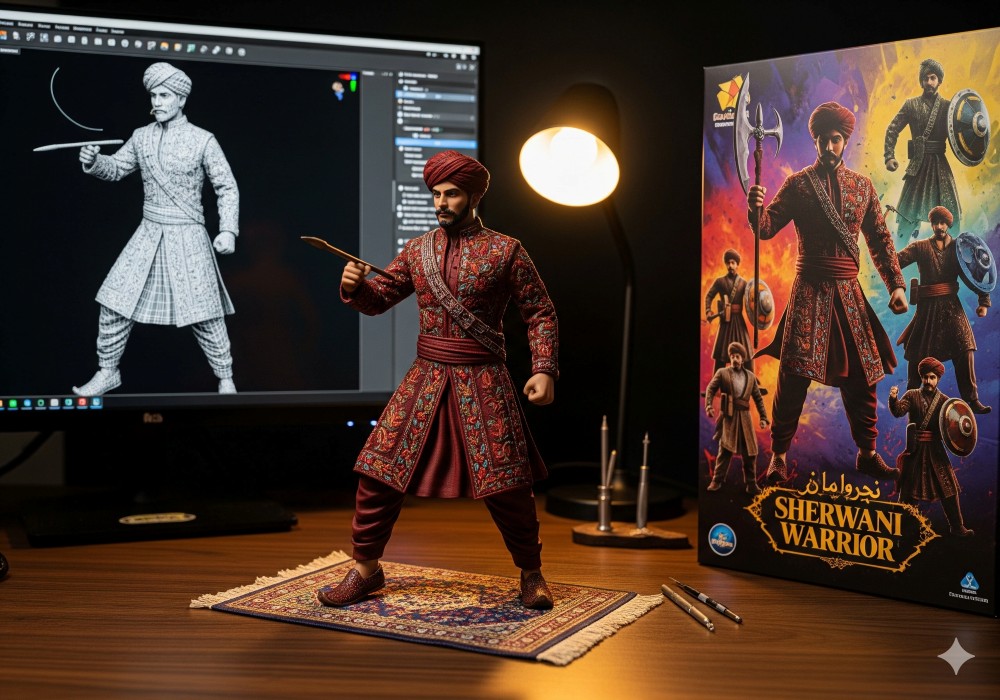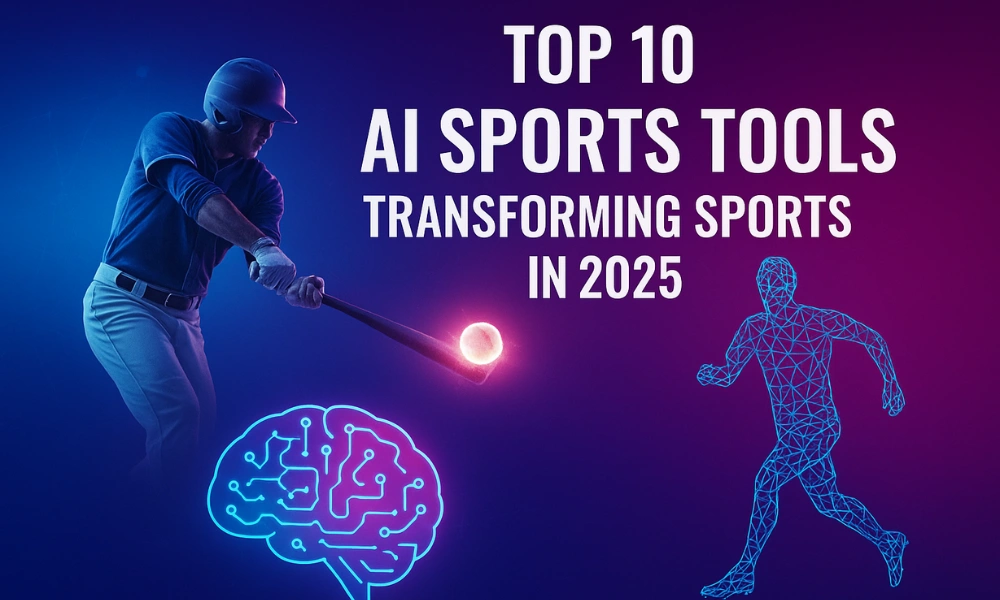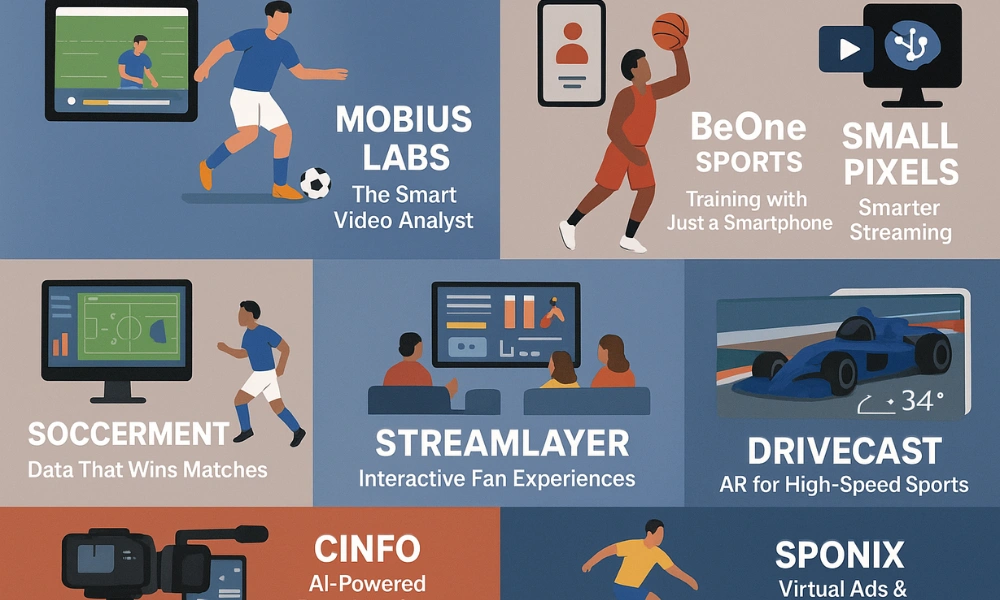
Game-Changers: Top 10 AI Sports Tools Reshaping Sports in 2025
- September 10, 2025
- Top Search
- 2:40 pm

In Short
AI is transforming sports in 2025 with smarter training, immersive fan experiences, and advanced broadcasting tools. These innovations reshape how games are played and enjoyed.
“🎧 Listen to this article instead of reading (audio version below).”
Introduction: The Rise of AI in Sports
Sports have always been about passion, skill, and performance. But in 2025, another powerful force is shaping the industry—Artificial Intelligence (AI).
AI is no longer confined to labs or tech startups; it’s making its way into stadiums, locker rooms, and even fans’ living rooms. From advanced performance analytics to immersive broadcasting, AI is helping athletes push their limits, coaches make smarter decisions, and fans enjoy richer experiences.
According to a report by Sports Business Journal, nearly 30% of all sports tech investments in 2025 involve AI-driven solutions—a sign of how fast the industry is evolving.
In this blog, we’ll explore the Top 10 AI Sports Tools of 2025, how they’re being used, and why they matter.

1. Mobius Labs – The Smart Video Analyst
Imagine never missing a highlight again. Mobius Labs uses AI-powered computer vision to analyze sports footage in real time. It can identify players, tag moments, and automatically create highlight reels within seconds.
Key Benefits:
Saves countless hours of manual editing
Makes sports archives searchable
Enables real-time highlights for fans and media
Example: Broadcasters can deliver instant highlight packages during live games, while clubs can use it to track player performance over an entire season.
2. BeOne Sports – Training with Just a Smartphone
Traditional motion-capture systems require expensive sensors. BeOne Sports breaks this barrier by offering AI-powered training through a smartphone camera.
Athletes can compare their performance with over 100 million motion data points, giving them insights into form, speed, and technique.
Key Benefits:
Affordable and accessible training
Real-time motion feedback
Ideal for both professional athletes and aspiring players
Example: A high school basketball player can use BeOne to refine shooting mechanics without hiring a professional coach.
3. Small Pixels – Smarter Streaming
For fans in regions with weak internet, buffering ruins the thrill. Small Pixels solves this by using AI to compress and optimize video—delivering HD-quality streams even on low bandwidth.
Key Benefits:
Cost-effective for broadcasters
Expands sports access to underserved regions
Enhances fan satisfaction
Example: Small leagues can now stream games to global audiences without investing in heavy infrastructure.
4. Soccerment – Data That Wins Matches
Soccerment is an AI-driven analytics platform designed for football (soccer). It merges proprietary and third-party data to provide deep insights into player performance, scouting, and match strategies.
Key Benefits:
Scouting players with accurate metrics
Improving tactical decisions
Supporting player development
Example: Coaches can analyze opponents’ weaknesses and design strategies with AI-powered dashboards before a match.
5. StreamLayer – Interactive Fan Experiences
Today’s fans want more than just watching—they want interaction. StreamLayer enables interactive live streams with overlays, real-time stats, watch parties, and dynamic ads.
Key Benefits:
Higher fan engagement
Increased advertising revenue
Personalized viewing experience
Example: Fans can host watch parties with real-time trivia, polls, and chat rooms during NBA or NFL games.
6. DriveCast – AR for High-Speed Sports
Covering motorsports or fast-action sports is challenging. DriveCast uses AI to track fast-moving objects and overlay AR graphics in real time.
Key Benefits:
Enhances storytelling in fast-action sports
Provides real-time insights for fans
Opens opportunities for AR-based ads
Example: During Formula 1, fans can see live telemetry data like speed and tire condition overlaid on their screens.
7. cinfo – AI-Powered Broadcasting
Small leagues often struggle with broadcasting costs. cinfo automates OTT (Over-the-Top) production using AI, making pro-level broadcasting affordable and scalable.
Key Benefits:
Cuts down production costs
Expands coverage for grassroots sports
Improves accessibility of sports content
Example: Amateur football clubs can now live stream matches with professional quality using cinfo.
8. Sponix – Virtual Ads & Immersive Replays
Sponix is changing the way fans watch games and brands advertise. Its AI overlays virtual ads on broadcasts and provides cinema-like immersive replays.
Key Benefits:
New revenue streams for leagues
More engaging replays for fans
Location-specific ads for sponsors
Example: Viewers in the U.S. see Coca-Cola ads while European fans see Pepsi—during the same live broadcast.
9. Providential Media Group (PMG) – AI for Fan Loyalty
PMG blends interactive technology with AI-driven analytics (powered by IBM) to build stronger fan-sponsor relationships.
Key Benefits:
Fan rewards based on interactions
Valuable sponsor analytics
AI-driven content personalization
Example: Fans earn points for posting match reactions and redeem them for merchandise or discounts.
10. RespoVision – 3D Tracking from a Single Camera
Most motion tracking needs multiple cameras. RespoVision disrupts this by turning single-camera footage into 3D skeletal models of athletes using AI.
Key Benefits:
Low-cost performance tracking
Immersive 3D replays
Valuable for training and fan visualization
Example: A single-camera setup can recreate a 3D model of a soccer player’s goal for fans to view from different angles.
Why These Tools Matter
Sports is no longer just physical—it’s digital. These AI tools:
Empower athletes with data-driven training
Help coaches make smarter tactical choices
Enable fans to enjoy immersive, personalized experiences
Create new revenue streams for sports organizations
In short, AI is reshaping every aspect of the sports ecosystem.
Case Study Snapshots
Oakland Ballers (Baseball): Used AI to make in-game decisions, marking the world’s first AI-managed professional game.
NBC Sports (NFL): Experimented with AI graphics, though fan reaction showed the need for balance between tech and creativity.
Conclusion
AI is no longer an experiment—it’s the backbone of sports innovation in 2025. From training apps to broadcasting platforms, these tools are transforming how sports are played, managed, and experienced.
As we move forward, expect AI to become as essential to sports as the scoreboard itself.
FAQs
AI reduces production costs, adds AR overlays, and enables interactive features like watch parties.
BeOne Sports, Soccerment, and RespoVision help athletes track and improve performance.
No. AI provides insights, but human judgment and leadership remain essential.
Over-reliance on automation, fan backlash (like NBC’s AI graphics), and data privacy concerns.
Absolutely. Personalized content, immersive replays, and interactive features are already boosting fan satisfaction.
Quora Insights
- How is artificial intelligence being used in sports analytics?
- What are some examples of AI being used in sports coaching and training?
- How will AI change the future of professional sports?
- What are the best AI tools for sports betting and fantasy sports?
- What are some of the most innovative startups using AI in the sports industry?

Recent Posts:


From Sketch to Screen: Fashion Designers Embrace AI Tools in 2025


